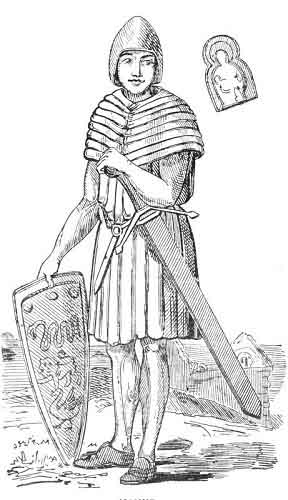
MANUS.
A poem so called is known in Ireland, and is preserved in MSS. in Dublin, according to writers in the transactions of the Ossianic Society.
A poem of 172 lines, "Comhrag Fhein agus Mhannis" was published in 1786, in Gillies' collection. An Irish version was published by Miss Brooke, 1789. I have compared my version with the poem in Gillies. I find that they vary from each other; in words, in lines, and even in whole stanzas; but the two might be fused so as to produce a third, perfectly genuine, and more complete than either. The version orally collected in 1860 goes a step beyond the other, printed in 1786, and I feel certain that it is historical. This story is in substance the same as "Fingal," and might be the germ of that poem. Irish writers claim it as Irish, and assert that the Lay of Magnus was MacPherson's original for part of Fingal. It first appeared in print in Scotland, and it is still repeated there, wherever it was composed. Irish collectors have copies taken down orally in Scotland long ago.
Now, if Magnus can be identified, it would fix the earliest possible date for the poem, and a later date for the poet than is usually given to Oisean, by Scotch and Irish writers; and this opinion agrees with Miss Brooke's.
The prose tale is also about Magnus; it was written by MacLean. I heard it recited by old MacPhie in 1860. He is failing fast, and cannot dictate slowly; I miss several of the measured prose passages, which I heard him repeat with the utmost fluency, when he
was allowed to go his own pace. The story is manifestly incomplete; and it reminds me of one which old MacPhie repeated a second time for me. He then gave disjointed incidents, and broken sentences, instead of a connected story in very good language, with few repetitions, with curious rhythmical passages interspersed, which he gave the first time.
It is hard to say what this story means, unless it is Celtic mythology engrafted upon a bit of Norwegian history.
I give it with all its shortcomings, because, if Celtic mythology is ever to be discovered, it will be found in some such shape.
We have here, at all events--
The King of the World, whose life is in that of a horned, deadly or hurtful or venomous animal; and his son Brodram.
The King of Light, who is conquered by a lion; and his son, the white long-haired one, whose life is in that of three fish; who has twelve bald ruddy daughters; who marry twelve men, the foster-brothers of Manus the hero.
Balcan, the smith, who has twelve apprentices; and his son, who is a sailor, and has a wonderful spotted ship, and twelve sailors.
In short, there are many things which suggest solar worship and mythology--Aries, Taurus, Leo, Pisces--12 hours of day, 12 of night, 12 months, 12 signs of the zodiac, Light, the Smith or artificer Balcan; the sailor, his son:--Vulcan and Neptune, &c. But while there is much to suggest inquiry, there is nothing definite.
The poem, on the contrary, is definite enough, and in that respect it resembles other poems which I have collected, and differs from the prose romances.
I have endeavoured to restore this dress from various authorities. From grave stones; two in Iona, and two in Islay, of which I happened to have very rough sketches; and from tradition.
I leave the legs bare, because there is no indication of any covering on the legs of the sculptured figures, and because Magnus the great was called "barelegs" when he adopted the dress of the islands, and because there is no mention of any covering for the legs in the traditional descriptions of dress. On the contrary, at page 442, vol. ii., it appears that the warriors had shoes, but that their legs were bare.
Some stones indicate that the arms were clothed in some material, with longitudinal folds; others indicate no covering.
The shape of the shield is from a stone at Iona. On some there are traces of armorial bearings.
The lion, snake, and griffin, are from the story as repeated to me by old MacPhie. "His boss-covered, hindering, sharp-pointed shield on his left arm, with many a picture to be seen thereon. Lion and Creveenach, and deadly serpent." A lion and a serpent appear in the Welsh romance of the Lady of the Fountain, which this story resembles in some degree.
The helmet and sword are copied from stones, some of which are roughly carved in relief nearly six inches above the surface.
The tippet and shirt are very like the dress commonly worn by the Lapps of the Luleo river, and by little Scotch children at the present day.
The Lapps wear a loose deer-skin shirt, and a belt round the waist, and a tall conical cap. In rainy weather they slip a tippet over their heads, which is tied round the forehead, and protects the chin, throat, and shoulders, covering all but the face.
Scotch children wear a kilt and sleeve-waistcoat in one, into which they slip, and which, with a shirt, often constitutes their whole attire.
The warrior's outer dress was probably some such garment made of leather, with iron scales. The same Gaelic word means patched cloak, and coat of mail, and such a dress seems to be meant at page 205, vol. ii. The virgin and child are from the stone in Kilnaughton church, Islay, and the symbol indicates a Christian warrior and a date.